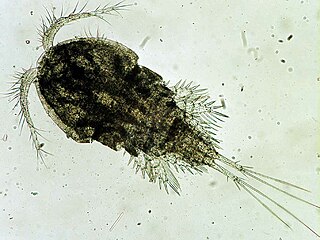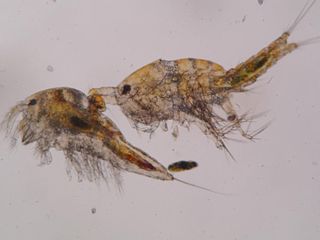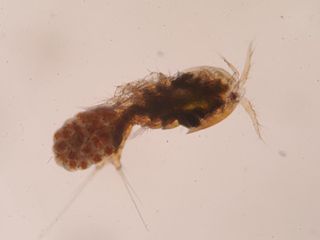| Canuellidae | |
|---|---|
| Scientific classification | |
| Kingdom: | Animalia |
| Phylum: | Arthropoda |
| Subphylum: | Crustacea |
| Subclass: | Copepoda |
| Order: | Polyarthra |
| Family: | Canuellidae |
Canuellidae is a family of copepods belonging to the order Polyarthra. [1] [2]
| Canuellidae | |
|---|---|
| Scientific classification | |
| Kingdom: | Animalia |
| Phylum: | Arthropoda |
| Subphylum: | Crustacea |
| Subclass: | Copepoda |
| Order: | Polyarthra |
| Family: | Canuellidae |
Canuellidae is a family of copepods belonging to the order Polyarthra. [1] [2]
The family contains the following genera: [2]

The Cyclopoida are an order of small crustaceans from the subclass Copepoda. Like many other copepods, members of Cyclopoida are small, planktonic animals living both in the sea and in freshwater habitats. They are capable of rapid movement. Their larval development is metamorphic, and the embryos are carried in paired or single sacs attached to first abdominal somite.

The World Association of Copepodologists (WAC) is a non-profit organization created to promote research on copepods by facilitating communication among interested specialists.
Leptocaris is a genus of copepods in the family Darcythompsoniidae. One species, the Mexican endemic L. stromatolicolus, is included on the IUCN Red List as a vulnerable species. The genus contains the following species:

Canthocamptidae is a family of copepods. Most of the 700 species are confined to fresh water, although there are also marine species. It contains the following genera:
Splanchnotrophidae is a family of cyclopoid copepods in the order Cyclopoida. There are about 7 genera and more than 30 described species in Splanchnotrophidae.
Karllangia is a genus of marine copepods. Its name commemorates the Swedish carcinologist Karl Georg Herman Lang. The genus contains five species:
Cletocamptus is a genus of marine and brackish-water copepods, containing the following species:
Robertgurneya is a genus of copepods, containing the following species:

Platycopiidae is a family of copepods. Until the description of Nanocopia in 1988, it contained the single genus Platycopia. It now contains four genera, three of which are monotypic; the exception is Platycopia, with 8 species.
Darcythompsoniidae is a family of copepods, containing four genera. Members of the family have a very wide distribution throughout the tropics, where they live in rotting mangrove leaves. They lack egg sacs and are thought to lay their eggs directly into the leaf litter.

Harpacticidae is a family of copepods, containing the following genera:

Tigriopus is a genus of copepods in the family Harpacticidae, containing the following species:

The clade Multicrustacea constitutes the largest superclass of crustaceans, containing approximately four-fifths of all described crustacean species, including crabs, lobsters, crayfish, shrimp, krill, prawns, woodlice, barnacles, copepods, amphipods, mantis shrimp and others. The largest branch of multicrustacea is the class Malacostraca.
Delavalia is a genus of copepods in the family Miraciidae.
Laophontidae is a family of copepods belonging to the order Harpacticoida.
Polyarthra is an order of copepods belonging to the class Copepoda.
Tachidiidae is a family of copepods belonging to the order Harpacticoida.
Cylindropsyllidae is a family of copepods belonging to the order Harpacticoida. It was first described by Sars in 1909
Paramesochridae is a family of copepods belonging to the order Harpacticoida.
Emertonia is a genus of copepods in the family Paramesochridae.